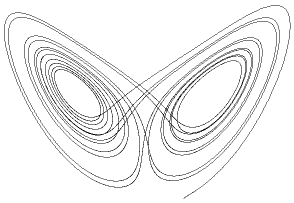Lorenz Mask Notes

Lorenz Mask, projected onto XZ plane
from
www.zeuscat.com/andrew/chaos/lorenz.html
-- the Lorenz Mask represents the solution to a three-dimensional
set of ordinary differential equations which can model the
unpredictable behavior of the weather; found by E. Lorenz of
MIT;
- dx/dt = P(y-x)
- dy/dt = Rx-y-xz
- dz/dt = xy-Kz
where x is the rate of convective overturning,
y is the horizontal temperature overturning,
z is the vertical temperature overturning;
and P is proportional to the Prandtl number (ratio of the fluid
viscosity of a substance to its thermal conductivity, usually set
at 10)
R is proportional to the Rayleigh number (difference in
temperature between the top and bottom of the system, usually set
at 28)
K is a number proportional to the physical proportions of
the region
under consideration (width to height ratio of the box
which holds the system, usually set at 8/3)
-- all
three numbers are positive since they all represent physical
quantities
-- convection is the process by which heat is
transferred by a moving fluid; Mask can be derived from
observing the convective motion in a 2-D fluid cell that is
warmed from below and cooled from above; though it seems
regular, this motion is actually chaotic
-- Ludwig Prandtl
is a German physicist who is considered to be the father of
aerodynamics
-- John William Strutt Rayleigh is an English
physical scientist who made discoveries in the fields of optics
and acoustics that are essential to the theory of wave
propagation in fluids
Observations:
- trajectory does not intersect itself in three dimensions
- trajectory is not periodic or transient
- general form of the shape does not depend on initial
conditions
- exact sequence of loops is very sensitive to the initial
conditions
Properties:
- symmetry: (x, y, z) --> (-x, -y, z) for all values of the
parameters
- the z-axis (x=y=0) is invariant (all trajectories that
start on it
also end on it)
Interesting
application:
-- Lorenz Mask used as an
encryption method for masking information-bearing waveforms
By Yvan Gauthier of Carleton University, April 1998.
-- On the transmitting end, an information-bearing signal
i(t) is added to an evolving Lorenz dynamical system
x to produce the output s(t), which is the masked
signal.
s(t) = x + i(t)
-- On
the receiving end, the process is reversed, and x is
subtracted from s(t), (hopefully) recovering the original
signal I(t).
I(t) = s(t) - x
-- Though this process does seem to work, it is highly
inefficient for periodic and high-frequency signals, but can be
used to mask other signals (such as voice signals).
Home

